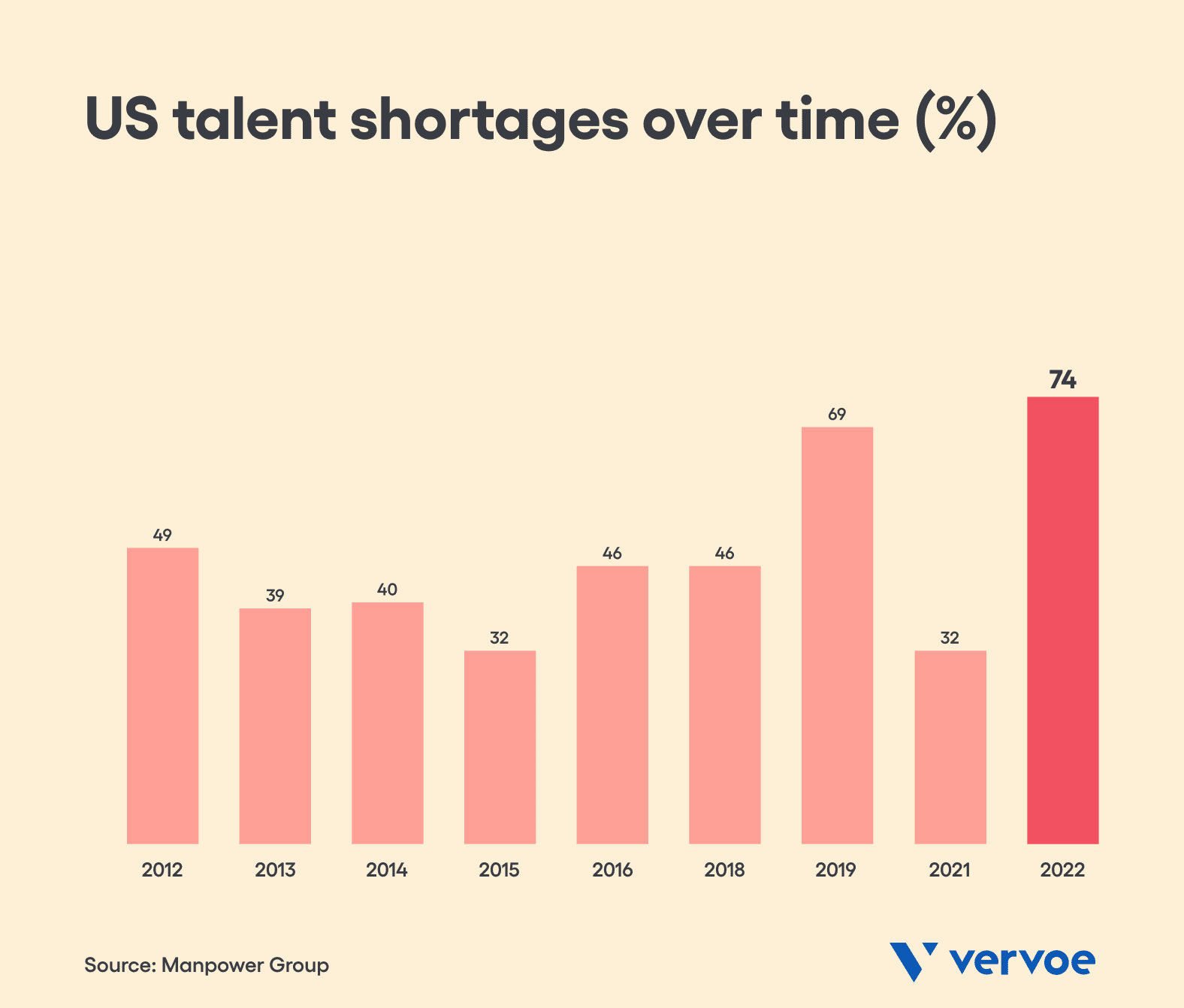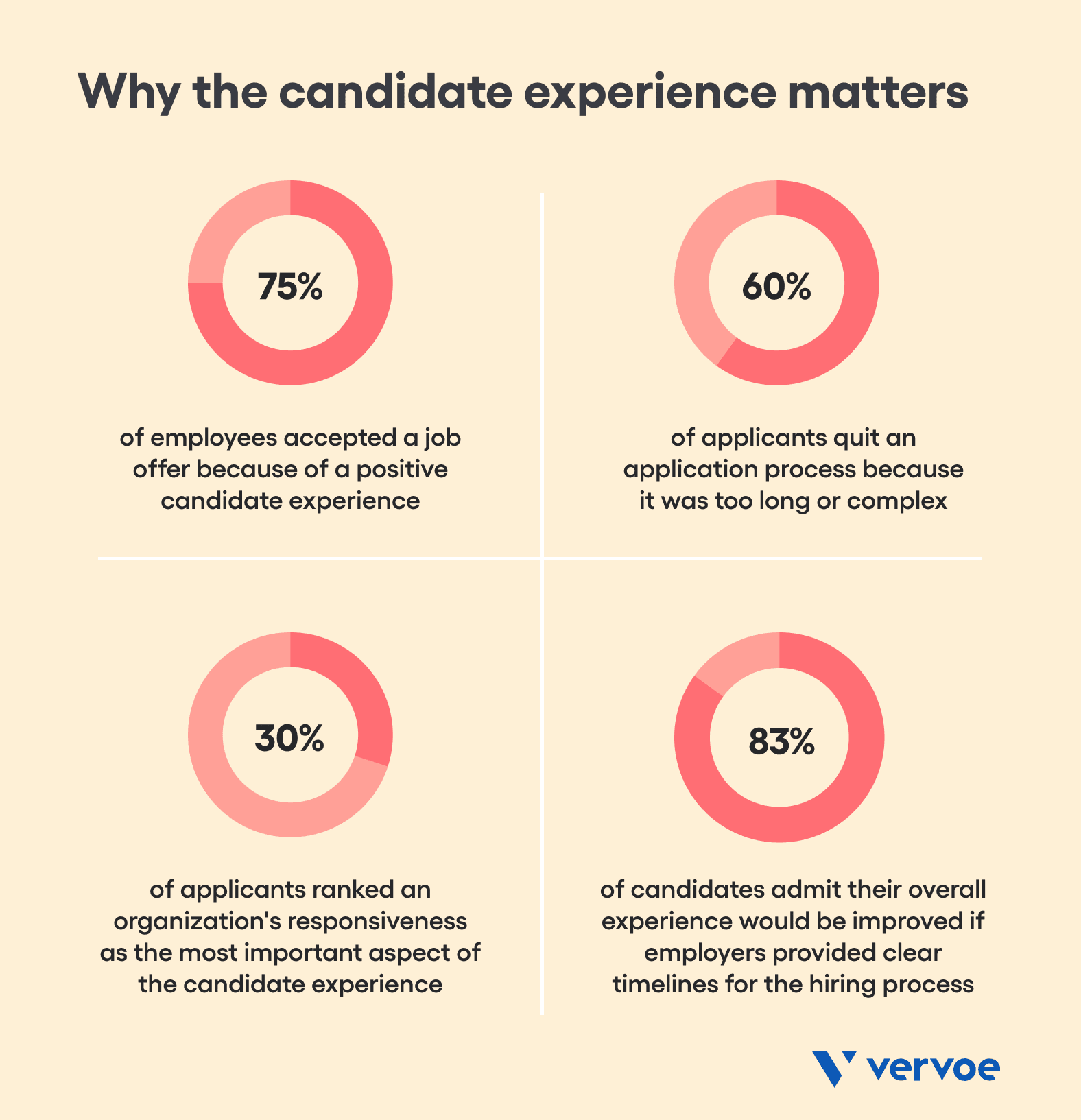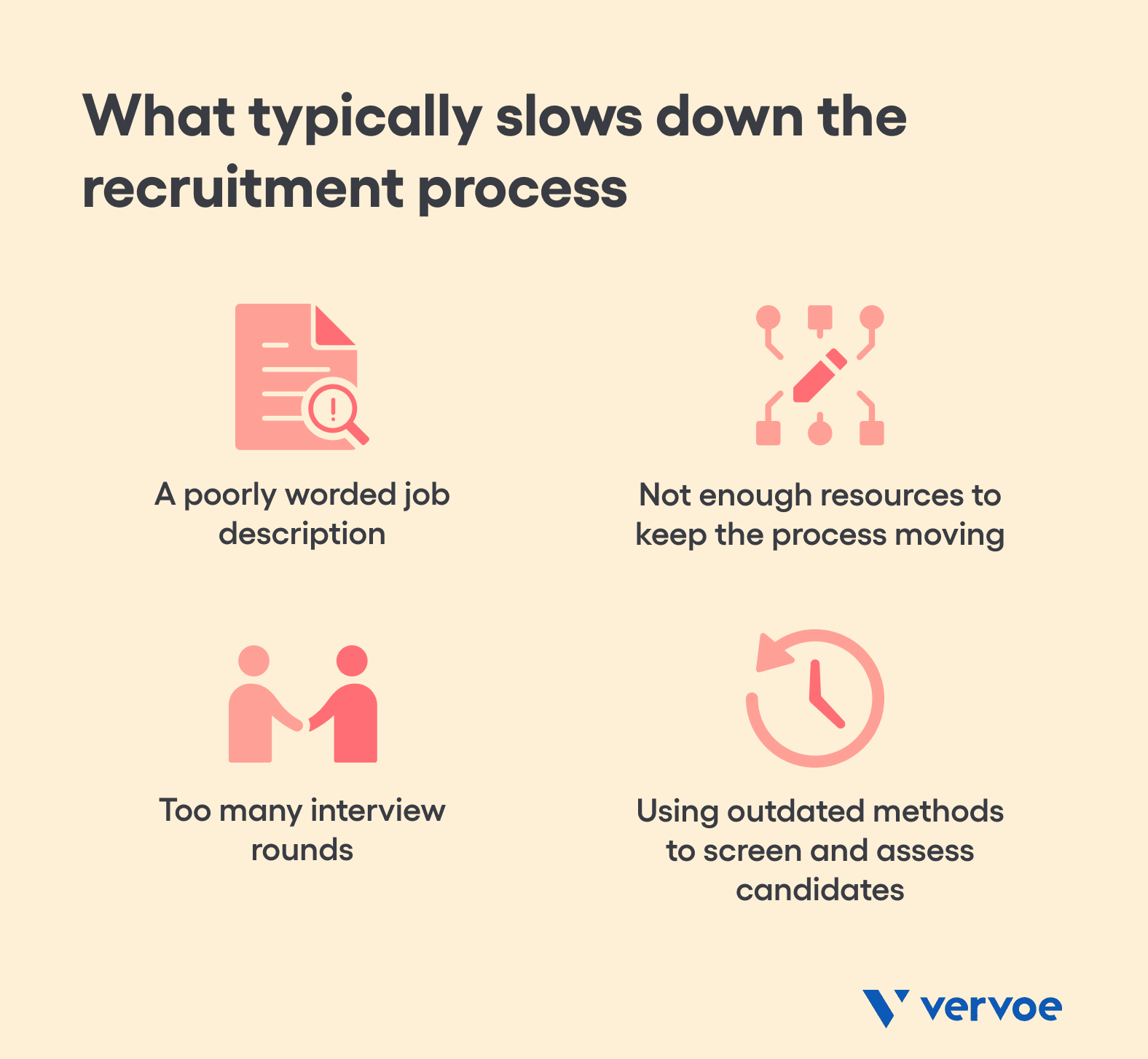Traditional hiring processes are notoriously slow and long-winded. That’s a fact. According to LinkedIn, it takes companies 41 days to hire, on average.
And unfortunately, the pandemic hasn’t done much to help the case of hiring managers across the globe. With fewer skilled candidates and greater competition than ever before, organizations are feeling the full weight of open job vacancies and understaffed teams.
The harsh reality? While you may have little influence over market factors that slow down your ability to hire at speed, there are plenty of factors you can alter to hire more efficiently without jeopardizing quality. According to Builtin.com, optimizing your job recruitment process can shorten your hiring cycle by 60% while improving quality.
Want to learn how? In this article, we’ll delve into the impact of a slow hiring process and what you can do to improve yours.
The US recruitment process — what does it currently look like?
From a lack of recruitment resources and lengthy hiring processes to insufficient skilled talent and growing competition, several factors play a role in slowing down the recruitment process. Let’s take a look at a few statistics that highlight the reality of recruitment in the United States:
- On average, it takes companies 41 days to hire.
- According to Glassdoor, job postings will receive, on average, 250 resumes — of which 4-6 candidates will go forward to the interview phase.
- The top candidates are generally off the market within ten days, according to Builtin.com.
- According to SHRM, only 8.6% of candidates who browse career sites apply for open roles.
- 74% of US organizations are struggling to find skilled talent for open roles, according to the ManpowerGroup survey.
- According to LinkedIn, 70% of the global workforce is passive talent, with the remaining 30% actively seeking jobs.
- 78% of large companies — those with 250+ employees — experience even more difficulty filling roles than small-to-medium-sized organizations.

The impact of a slow hiring process on your organization
1. You’re potentially throwing money down the drain
It’s no secret that hiring new employees is an investment in your company’s future. Yet, as the old saying goes, “nothing in this world is free,” which couldn’t be more true for recruitment.
The average cost per hire alone has risen to $4,000 per employee. Yet, this price doesn’t factor in the cost of leaving positions unfilled for a significant amount of time. And often, that price can be hard to quantify.
Let’s break this down a little. Every day you leave a position unfilled, you’re paying the cost in unmet potential productivity and revenue. Without adequate team resources, it’s likely to stall workflow and projects, limit productivity, and place additional pressure on existing employees to make up the difference.
When considering lost revenue, this is particularly detrimental in revenue-generating roles, such as sales. However, it has a bottom-line impact on all positions within an organization. Consider what role you’re trying to fill and evaluate what financial loss might look like from all angles.
2. You’ll let great candidates slip away
In 2015, a staggering 47% of declined job offers were the result of candidates accepting other jobs, according to MRINetwork.
The reality is: you’re likely not the only role your candidates are applying for. If you expect your candidates to go through long-winded recruitment processes, you’re more likely to lose them to competitors that offer a more streamlined experience.
According to Builtin.com, top-performing candidates are generally snatched up within ten days. This means there’s no room to contemplate or unnecessarily extend the recruitment process should your primary goal be finding quality talent. Secondly, it also proves that taking your time won’t always get you the best candidate.
Unless you’re a well-known brand like Google or Apple, you can’t afford a clunky or time-consuming hiring process. In fact, according to an SHRM study, 60% of applicants quit halfway through an online job application process if it’s too long or complex.
If you’re sourcing talent for in-demand roles — including nurse practitioners, data scientists, information security analysts, statisticians, web developers, etc. — you must ensure your recruitment process is optimized for efficiency.
3. It can impact your employer brand
A bad candidate experience caused by a slow hiring process can negatively affect your brand reputation. Unfortunately, in the age of social media and transparent platforms like Glassdoor and Indeed, a negative candidate experience can reach a broad audience.
More often than not, your hiring process accurately reflects how your company functions and operates. As such, candidates are likely to think twice about recommending your company, reapplying for future roles, or continuing with an existing application if the recruitment process is slow and progress updates are lacking.
Consider the following findings from FinancesOnline:
- 75% of employees accepted a job offer because of the positive candidate experience they had during the hiring process.
- 60% of applicants quit the application process if it’s too long or complex.
- 30% of applicants ranked an organization’s responsiveness the most important aspect of the candidate experience.
- 83% of candidates admit that their overall experience would be improved if employers provided clear timelines of the hiring process.

Corroborating these findings is a Robert Half survey, which found that 57% of respondents believe the most frustrating part of a job search is waiting to hear back from an organization about whether or not they were successful in the interview process. The findings suggest candidates, particularly in today’s market, lose interest the longer they don’t hear back:
- Almost one-quarter lose interest if they don’t hear back within one week.
- 46% lose interest if they don’t receive any status updates within one to two weeks after their interview.
- 39% admit a long-winded recruitment process altogether would make them lose interest and assess alternative opportunities.
The issue with a poor candidate experience? Applicants are more likely to broadcast it. According to a CareerArc survey, almost 60% of candidates surveyed said they had a poor candidate experience, with 72% sharing their experience on an online platform or to a direct contact.
Conversely, a strong candidate experience will positively impact your employer brand, helping you attract and engage better candidates.
Consider the following findings from a Glassdoor guide that demonstrates the importance of a strong employer brand:
- 74% of Glassdoor users are more likely to apply for a job if the employer actively maintains its employer brand, which includes responding to reviews, demonstrating company culture, and regularly updating their profile.
- Organizations that invest in employer branding are 3x more likely to make a better quality hire than those who don’t.
- The quality of hire improves by 70% when organizations invest in a strong candidate experience.
- Most Glassdoor users read approximately seven reviews before deciding if a company is right for them.
4. Your existing team will likely feel the full weight
When a role remains unfilled, the workload doesn’t just magically disappear. Instead, it’s shared amongst the existing team until the position is filled. Or in cases where the workload cannot be shared, unfilled positions will stall projects, impacting team productivity and job satisfaction.
The unfortunate reality? The impact of leaving a position unfilled for an extended period can result in various internal problems, including:
- A dissatisfied and unproductive team
- A burnt-out team
- Costly errors made on the job
- Negativity and low morale
- Staff turnover
It’s a candidate’s market, which means if your employees don’t feel valued and satisfied in their role, they may willingly jump ship to a more desirable option, leaving you with more positions to fill. According to Gallup, the cost of replacing an employee can range from one-half to two times their salary. For instance, if your employee makes an annual salary of $50,000, it could cost your organization upwards of $100,000. And according to Gallup, that’s a conservative figure.
What typically slows down the recruitment process?
Several factors influence the length of an organization’s recruitment process. For some, it will be a lack of applicants due to a poorly written job description; for others, it may be a lack of recruitment resources or too many unnecessary processes. Let’s take a closer look at a few common recruitment problems that slow down the process and what you can do to solve them.
1. Poorly worded job description
To construct a well-written job description, you must have a firm grasp of your ideal candidate. If you’re unsure, it’ll seep into the language used in your job description, either confusing candidates or encouraging unsuitable applicants to apply. Both of these outcomes can drastically slow down the recruitment process. Consider the following before you start writing:
- Who is your ideal candidate? — create a profile of what this person looks like (consider their skills, experience, career path, etc.)
- Barriers to entry that may be holding candidates back from applying — i.e., do you have unnecessary education requirements that may not affect the role’s success? If so, remove them.
- Hard and soft skills required to succeed in the job — think of what technical competencies and soft skills will be most beneficial to the role and company.
- How to keep it simple and to the point — a job description doesn’t need to include every detail. Include what matters and educate your candidates on your company as you go.
[Read More: How to Write Effective Skills-Based Job Descriptions in 4 Easy Steps]
2. Not enough resources to keep the process moving
A common problem is a need for more recruitment resources. Unfortunately, screening resumes, interviewing candidates, and assessing their capabilities is tedious and time-consuming. When left in the hands of a small team, it’s likely to stall the process. Realistically, there are only two effective ways to combat this issue:
- Hire more recruitment resources
- Build a more efficient recruitment process aided by technology (i.e., implement AI to help automate many of the manual tasks)
3. Too many interview rounds
When it comes to the recruitment process, there are often many people involved in the process. Initially, the recruiter or hiring manager will likely sift through resumes and screen applicants to create a shortlist. From here, the hiring manager may conduct an initial interview to understand their suitability. Once there’s confidence in the selected candidates, many organizations will run candidates through multiple interview stages to assess their capabilities based on stakeholders’ varying areas of interest. While this might make sense internally, it creates a reasonably poor candidate experience and delays the recruitment process.
The solution? Opt for a structured interview process and compile all the stakeholders’ questions into one interview.
[Read More: What Is A Structured Interview? Why They Work and How to Conduct One?]
4. Using outdated methods to screen and assess candidates
Let’s be honest for a second: The traditional recruitment structure we’ve always relied on has had its moment, but it no longer cuts it in today’s fast-paced market. Traditionally, organizations would post a job listing (often based on assumed knowledge and education requirements) and manually screen candidates to shortlist those they believed, off face value, were most suitable for the next round. Hiring managers would then interview talent (often using an unstructured interview process) before either progressing them to further rounds of interviewing or offering them the job.
While this served its purpose once upon a time, technology has advanced too far for us to continue ignoring the opportunities in front of us that allow organizations to recruit more accurately, efficiently, and at scale.
Whether resources are skim or abundant, the traditional recruitment method is a surefire way to add unnecessary length to your hiring process.

How can you shorten your recruitment process?
You can take plenty of small steps to help shorten your recruitment process (including those above). Still, we believe there’s only one all-in-one solution that’ll help streamline the entire process without compromising quality — irrespective of your team size, how large your candidate pool is, or how many you’re people you’re hoping to recruit.
Yep, we’re talking about Vervoe, our AI-powered job simulation platform.
A job-related simulation is a recruiting test that mimics the real responsibilities and tasks an employee would perform in the role. Online job simulation assessments allow a hiring team to assess the degree to which a candidate is prepared to take on the role in question.
They aim to provide more insight into a candidate’s capabilities than a cover letter or CV can offer. In a job market where resumes are unreliable, job simulations even the playing field for all candidates.
How Vervoe works
Vervoe is a software platform that verifies skills in the context of a job to give you the clearest idea of how a candidate will perform in your open role.
Vervoe gives employers a more efficient and accurate way to assess candidates’ skills and predict actual job performance (rather than perceived performance). It does all of this without you having to rely on someone’s background, pedigree, or fickle predictors of success to make critical hiring decisions. The cherry on top? Our intuitive machine learning AI will automatically grade and rank candidates to help speed up the process while reducing human bias.
Here’s why organizations — from IBM and G4S to Walmart and everyone in between — love Vervoe:
- It drastically speeds up the hiring process — With skills assessments, it removes the need for interviews and, in some cases, resume screening. Putting candidates through a skills assessment allows you to easily see who has the skills needed to succeed in the job. Likewise, our AI will automatically grade and rank candidates, meaning you’ll be able to see your top performers in just minutes.
- It’s accurate — Vervoe’s machine learning AI uses three different models to measure and predict performance. Our AI looks at how your candidate responds, as well as how they interact with the assessment, ensuring it recommends only the most suitable candidates.
- It widens your talent pool — Switching to a skills-based hiring approach gives all candidates equal opportunity to prove their capabilities. Experience, personality type, and formal education aren’t factored into decision-making, giving organizations access to talent they may have previously overlooked.
- It gives candidates a realistic job preview — Skills assessments help minimize job shock and employee attrition by allowing candidates to experience a day in the life of the role. This provides them with clear expectations and an accurate representation of the job before deciding if it’s the right fit for them.
- It predicts candidate performance — Skills assessments run applicants through a job simulation to test their skills against the role’s requirements. Doing so proves that candidates have what it takes to succeed in the role, adding confidence to hiring decisions and reassurance that the chosen person is the most qualified.
Final thoughts
The demand for top-tier talent is undeniable. With skills shortages occurring at every corner of the globe, it’s created a much-needed moment for organizations to consider how and where their recruitment processes may contribute to their inability to hire quality candidates.
From poorly articulated job posts to long-winded traditional recruitment practices, various factors impact a company’s ability to hire the right candidates quickly. Yet, studies have shown that optimizing your job recruitment process can help shorten the hiring cycle by up to 60%.
Implementing a job simulation platform like Vervoe is an effective way to hire great-quality candidates with efficiency and accuracy. Not only does it predict candidate performance easily, but it will also give candidates a realistic job preview — giving parties added confidence in the hiring process.




















